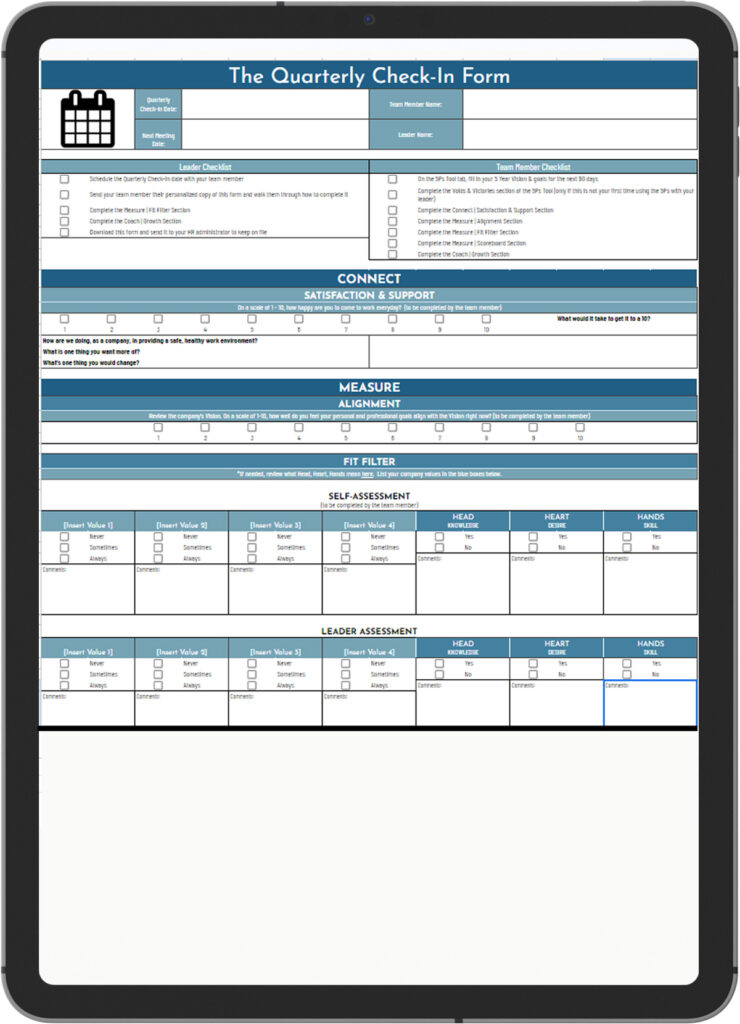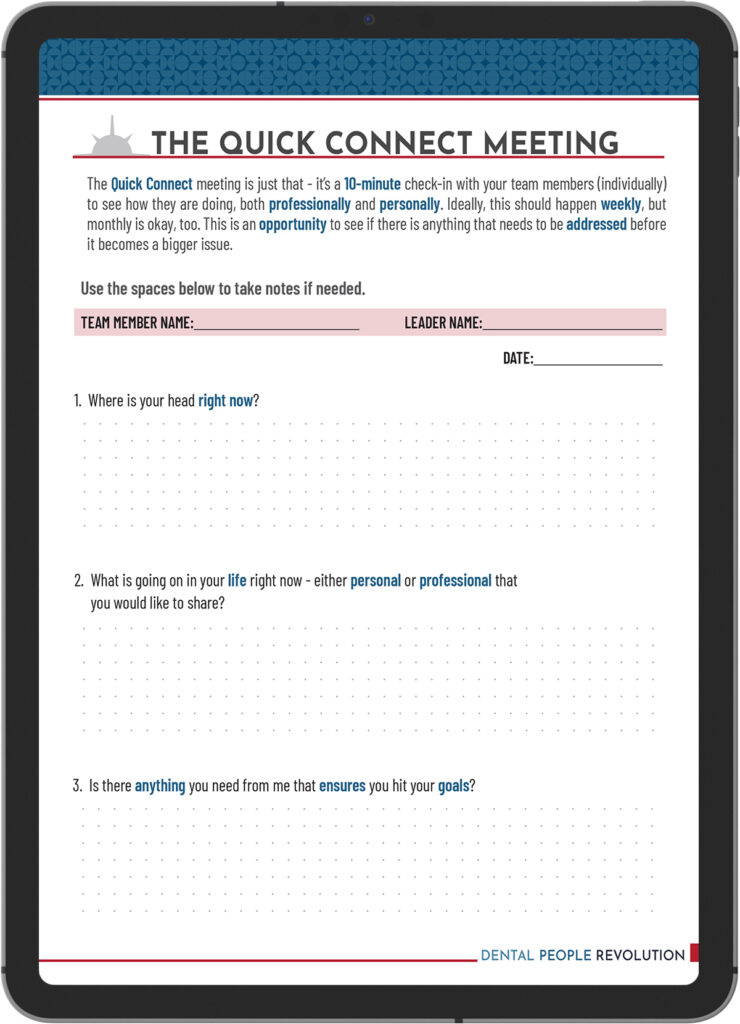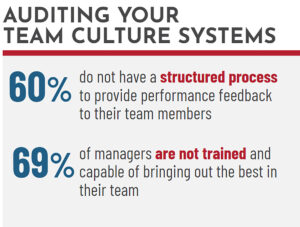Manager’s can rebuild and repair your company culture by connecting, measuring, and coaching the team members that report to them.
Management is a balancing act – while the very nature of your role is to oversee the office and the teams that you are responsible for, most people aren’t looking for a manager in today’s work environment. They want a coach to help them navigate the dynamics of the dental industry, which means that we need to make a transition in how we lead our people.
After years of working with team members and doing our best to understand how we can lead them in a meaningful way, we have found that playing the role of coach vs. manager continues to make the most impact inside organizations.
The manager’s job is to connect, measure and coach each of your team members. Utilizing this tool for your organization will help you to rebuild and repair your company culture, while positioning your organization to propel forward with a renewed sense of focus.
No matter where you are in the process, there is always room for improvement. We can always get better and grow from this experience. This isn’t only the most important thing that you will do as a leader, it’s also an excellent tool to use within your personal life.
The role of the modern manager
One of the first things you may recognize about being a modern manager is that it has evolved into much more of a partnership than a hierarchy. This means that any communication regarding feedback is more of a two-way street, allowing your team the opportunity to give feedback as well. This structured process is a great way to start facilitating a coaching environment.
Based on data collected from a recent DEO event, 60% of the members polled do not have a structured process to provide performance feedback, and 69% of managers are not trained and capable of bringing out the best in their teams. The most revealing part about this data is that such a large majority of managers within the dental space don’t feel confident leading their teams effectively, nor do they have the structured process in place to facilitate feedback.
There are plenty of managers and leaders of dental practices that would talk about the health of their organization through the lens of company culture. But the truth is that if your culture is not helping you drive results, it’s not doing its job. Company culture is so much more than free lunches and Casual Fridays – it’s the structured process to move people from one spot to the next.
The performance of your team is a significant part of a great culture. You might all like each other and get along, but if your teams aren’t engaged with the work and getting results, your culture is not healthy. As leaders, we need to make our expectations for performance clear, while setting up the parameters for what a healthy culture can look like within our businesses. These ideas aren’t mutually exclusive! They need each other to truly succeed, which is why Connect, Measure, Coach is such powerful tool for managers.
Connect
It’s impossible to truly separate our work lives from our personal lives. When we are experiencing challenges at home, they usually follow us into work, and vice versa. There is no way to get around the human experience, which means that we need to work to truly connect with our people. We need to find out who they are, what they are interested in, what their goals are, and what’s important to them.
Building meaningful connections with your team will drive trust – when we have trust, we have the opportunity to offer better feedback, which will then lead to the measuring and coaching part of the process. It all starts with connection.
There are some leaders who don’t see the value in connection. It either takes too much time or energy to figure out what’s going on inside their world. But there is proof that, if done correctly, it will take less time for you to build a connection with your team than find another plan of attack. Essentially, you are fighting fires within your business right now because your team isn’t performing, and your team isn’t performing because you aren’t connecting with them.
People are leaving the industry or quitting companies because they don’t feel a connection to their manager. When we invest a small amount of time and focus it in the right ways, we get more out of our team and create more free space for us as managers.
Here are some connection tools that you can implement within your practice:
- Quick connect – A quick connect is a 15-minute, monthly meeting that is a great way to touch base with individual team members. This needs to be a safe space where your team can feel comfortable talking about the things that are important to them, whether it’s work-related or not.
- Quarterly check-in – The quarterly check-in is a structured process that could prove to be more efficient than an annual review. By ensuring that you are checking in with your team on a regular basis, you can gauge the health and well-being of your company culture, while making adjustments where it’s needed most.


Measure
When we have clear goals and expectations, measuring and managing performance becomes much simpler. Everyone deserves validation – we need to know where we stand and how well we are performing. We need to have an objective way to know that we are doing our best.
Everyone in your organization should have one to three Key Performance Indicators (KPIs) that they are responsible for, but they may not know how to operationalize them and integrate them into their performance. A huge piece of the quarterly check-in is measuring KPIs against performance, looking for ways to improve and streamline any of the processes that person is responsible for. When you’re looking through the “measure” lens, you want to see if your practice has trends going up, even if they aren’t hitting the right numbers.
We also measure to ensure that that everyone aligns to the core values of the team. This measure lens is designed to measure alignment to vision, alignment to values, and alignment to KPIs. Alignment is critical to the success of any organization – if your employes aren’t aligned to what you are trying to do as a company, it will be much harder to meet your goals and drive productivity.
Coach
Coaching your teams allows you to identify areas where they can improve, but also how you can provide support to them. With this approach, you can give your team members the space to make mistakes and learn from them. Asking the right questions can help them to better understand what went wrong and how they can navigate scenarios like that in the future.
In order to effectively lead as a coach, it’s important to understand the difference between a coach and a manager. The biggest difference between managers and coaches is the mindset – traditionally, managers come to situations with a sense of formal authority over the team. With this mentality, managers often make decisions on behalf of the team. Coaches tend to come to these situations on an equal footing with the team, allowing the team members to make their own decisions, within the parameters of the values and vision of the practice. Operating with that mindset is certainly not the wrong approach, but it does result in a specific dynamic within the organization.
Amongst many other things, coaches are also focused on the personal and professional development of the people who work for them. Their goal orientation is inclusive of the people who are performing the tasks and processes that achieve those goals, while managers tend to have a focus on pushing organizational targets. Managers might say you didn’t score, while coaches are more likely to help find a different approach.
The bottom line is, if we do a great job at coaching, we have very little to do with managing. Everything else will likely fall into place if you have the coaching approach. As leaders, we have a duty to focus our energy to ensure that we can have the right conversations, cultivate the right relationships, and unlock the potential of our teams.






